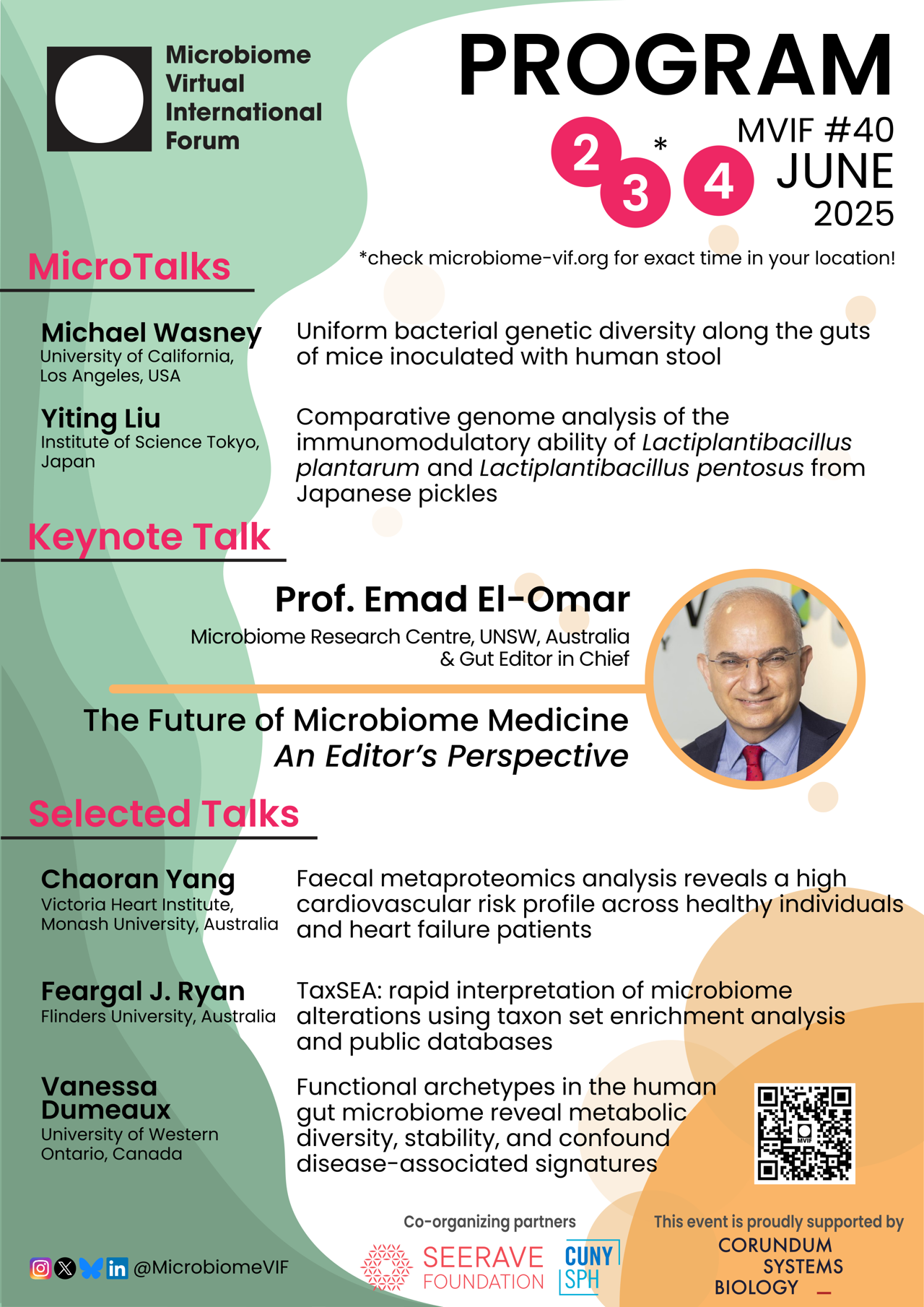Keynote talk
The Future of Microbiome Medicine – An Editor’s Perspective
By Prof. Emad El-Omar, Editor in Chief of the journal Gut
The microbiome field continues to grow at an exponential rate with sophisticated approaches that are pushing the frontiers of science and translating fast into clinical practice. The past year has witnessed sustained progress in microbiome research with a shift towards high quality mechanistic studies, Artificial Intelligence-Machine Learning approaches and clinical trials with microbiome therapeutics. However, there are TWO fundamental areas of research that have lagged behind and are in desperate need of resolution. The first is the comprehensive characterisation of the so-called “healthy microbiome”, and the second is the establishment of robust longitudinal clinical studies where the starting point, or baseline state, predates the development of the disease or condition.
The advances in microbiome science over the past year are too numerous to mention and this lecture will offer an update on the most exciting stories so far! One particular area that has seen exciting recent progress is the greater understanding of the impact of diet on the microbiome and vice versa. A key publication has explored the signatures of vegan, vegetarian and omnivore diets and their relationships to health outcomes. This work reinforces how humans can shape their own gut microbiomes, and by extension their health, directly through simple dietary choices as well as more indirectly through agricultural and food production practices. Other work has shown how microbial transformation of dietary xenobiotics shapes the gut microbiome composition and explains why the same dietary compounds can have different effects on the microbiomes of different individuals. More work has looked at how the cardiometabolic benefits of certain diets (e.g., non-industrialised diets and African Heritage diets) are linked to microbiome modulation.
The finding that species from the Oscillibacter genus are associated with decreased faecal and plasma cholesterol levels is noteworthy and offers the prospect of potential benefits for lipid homeostasis and cardiovascular, renal and metabolic health. This is the more exciting with the very recent discovery of the hormone Cholesin, which is capable of inhibiting cholesterol synthesis in the liver, leading to a reduction in circulating cholesterol levels.
The lecture will also discuss recent advances in microbiome therapeutics and will conclude by discussing some of the recent guidelines related to microbiome research (e.g., establishing causality, use of pre-clinical models and therapeutic applications), development of live biotherapeutic products and microbiome testing in clinical practice. Finally, we will lay out a vision for the future of how microbiome medicine could be integrated into routine clinical practice.
MicroTalks
Uniform bacterial genetic diversity along the guts of mice inoculated with human stool
By Michael Wasney, University of California, Los Angeles
Environmental gradients exist throughout the digestive tract, driving spatial variation in the membership and abundance of bacterial species along the gut. However, less is known about the distribution of genetic diversity within bacterial species along the gut. Understanding this distribution is important because bacterial genetic variants confer traits important for the functioning of the microbiome and are also known to impart phenotypes to the hosts, including local inflammation along the gut and the ability to digest food. Thus, to be able to understand how the microbiome functions at a mechanistic level, it is essential to understand how genetic diversity is organized along the gut and the ecological and evolutionary processes that give rise to this organization. In this study, we analyzed bacterial genetic diversity of approximately 30 common gut commensals in five regions along the gut lumen in germ-free mice colonized with the same healthy human stool sample. While species membership and abundances varied considerably along the gut, genetic diversity within species was substantially more uniform. Driving this uniformity were similar strain frequencies along the gut, implying that multiple, genetically divergent strains of the same species can coexist within a host without spatially segregating. Additionally, the approximately 60 unique evolutionary adaptations arising within mice tended to sweep throughout the gut, showing little specificity for particular regions. Together, our findings show that genetic diversity may be more uniform along the gut than species diversity, which implies that species presence-absence may play a larger role than genetic variation in responding to spatially varied environmental pressures in the gut microbiome.
Comparative genome analysis of the immunomodulatory ability of Lactiplantibacillus plantarum and Lactiplantibacillus pentosus from Japanese pickles
By Yiting Liu, Institute of science Tokyo
Lactic acid bacteria (LAB) are pivotal in food preservation and exhibit immunomodulatory effects on interleukin-10 (IL-10) and interleukin-12 (IL-12) production. Lactiplantibacillus plantarum (L. plantarum) and Lactiplantibacillus pentosus (L. pentosus) from fermented food are known for their effect; however, a comprehensive comparative genome analysis is needed to identify the linked genes. Here, we investigated the immunomodulatory capability at the genome level of L. plantarum and L. pentosus strains isolated from Japanese pickles at the genome level, and we further identified their immunomodulation-associated genes using the potential-gene (PG) index derived from the Calinski–Harabasz (CH) index. The results revealed an immunostimulatory clade with strain-specific IL-10 and IL-12 induction and identified key genes via the PG index. Both genes across two species were shown to encode the enzyme TagF2, which is crucial for synthesizing poly-glycerol-3-phosphate type wall teichoic acid (poly-GroP WTA), indicating that TagF2 plays a potential role as an effective microbe-associated-molecular-pattern. In vivo analyses confirmed the IL-10-inducing ability of one strain, reinforcing the IL-10-stimulating capacity of its poly-GroP WTA. Subpotential genes in L. plantarum TagF2-possessing strains were linked to host‒cell interactions, suggesting that such strains play potential probiotic roles. Collectively, the PG index effectively identified immunomodulation-related genes, thus paving the way for the use of the PG index to detect potential health benefit-associated genes in other LAB species.
Selected Talks
Faecal metaproteomics analysis reveals a high cardiovascular risk profile across healthy individuals and heart failure patients
By Chaoran Yang, Monash University
The gut microbiota is a crucial link between diet and cardiovascular disease (CVD). Using fecal metaproteomics, a method that concurrently captures human gut and microbiome proteins, we determined the crosstalk between gut microbiome, diet, gut health, and CVD. Traditional CVD risk factors (age, BMI, sex, blood pressure) explained < 10% of the proteome variance. However, unsupervised human protein-based clustering analysis revealed two distinct CVD risk clusters (low-risk and high-risk) with different blood pressure (by 9 mmHg) and sex-dependent dietary potassium and fiber intake. In the human proteome, the low-risk group had lower angiotensin-converting enzymes, inflammatory proteins associated with neutrophil extracellular trap formation and auto-immune diseases. In the microbial proteome, the low-risk group had higher expression of phosphate acetyltransferase that produces SCFAs, particularly in fiber-fermenting bacteria. This model identified severity across phenotypes in heart failure patients and long-term risk of cardiovascular events in a large population-based cohort. These findings underscore multifactorial gut-to-host mechanisms that may underlie risk factors for CVD.
TaxSEA: rapid interpretation of microbiome alterations using taxon set enrichment analysis and public databases
By Feargal J. Ryan, Flinders University
Microbial communities are essential regulators of ecosystem function, with their composition commonly assessed through DNA sequencing. Most current tools focus on detecting changes among individual taxa (e.g. species or genera), however in other omics fields, such as transcriptomics, enrichment analyses like gene set enrichment analysis are commonly used to uncover patterns not seen with individual features. Here, we introduce TaxSEA, a taxon set enrichment analysis tool available as an R package, a web portal (https://shiny.taxsea.app), and a Python package. TaxSEA integrates taxon sets from five public microbiota databases (BugSigDB, MiMeDB, GutMGene, mBodyMap, and GMRepoV2) while also allowing users to incorporate custom sets such as taxonomic groupings. In silico assessments show TaxSEA is accurate across a range of set sizes. When applied to differential abundance analysis output from inflammatory bowel disease and type 2 diabetes metagenomic data, TaxSEA can rapidly identify changes in functional groups corresponding to known associations. We also show that TaxSEA is robust to the choice of differential abundance analysis package. In summary, TaxSEA enables researchers to efficiently contextualize their findings within the broader microbiome literature, facilitating rapid interpretation, and advancing understanding of microbiome–host and environmental interactions.
Functional archetypes in the human gut microbiome reveal metabolic diversity, stability, and confound disease-associated signatures.
By Vanessa Dumeaux, Western University
Understanding the functional diversity of the gut microbiome is essential for decoding its roles in health and disease. Using a deep-learning framework, we identified three functional archetypes defining healthy adult gut microbiomes, each characterized by specific metabolic potentials: sugar metabolism with branched-chain amino acid and cell wall synthesis (Archetype 1), fatty acid and TCA cycle metabolism (Archetype 2), and amino acid and nitrogen metabolism (Archetype 3). Archetype proximity is linked to stability, with Archetype 2 representing the most resilient state, likely due to its metabolic flexibility. Functional diversity emerged as a confounder in disease-associated microbial signatures. In inflammatory bowel disease, we observed archetype-specific shifts, including increased carbohydrate metabolism in Archetype 1-dominant samples and inflammatory pathways in Archetype 3-dominant samples, suggesting distinct opportunities for microbiome-targeted interventions. This framework addresses key challenges in microbiome research, including inter-individual variability and confounding, while providing robust insights into disease-associated functional shifts and microbial ecosystem dynamics.

